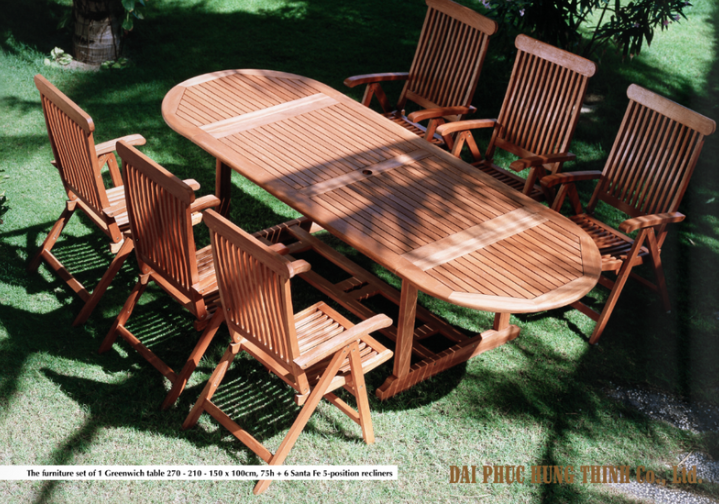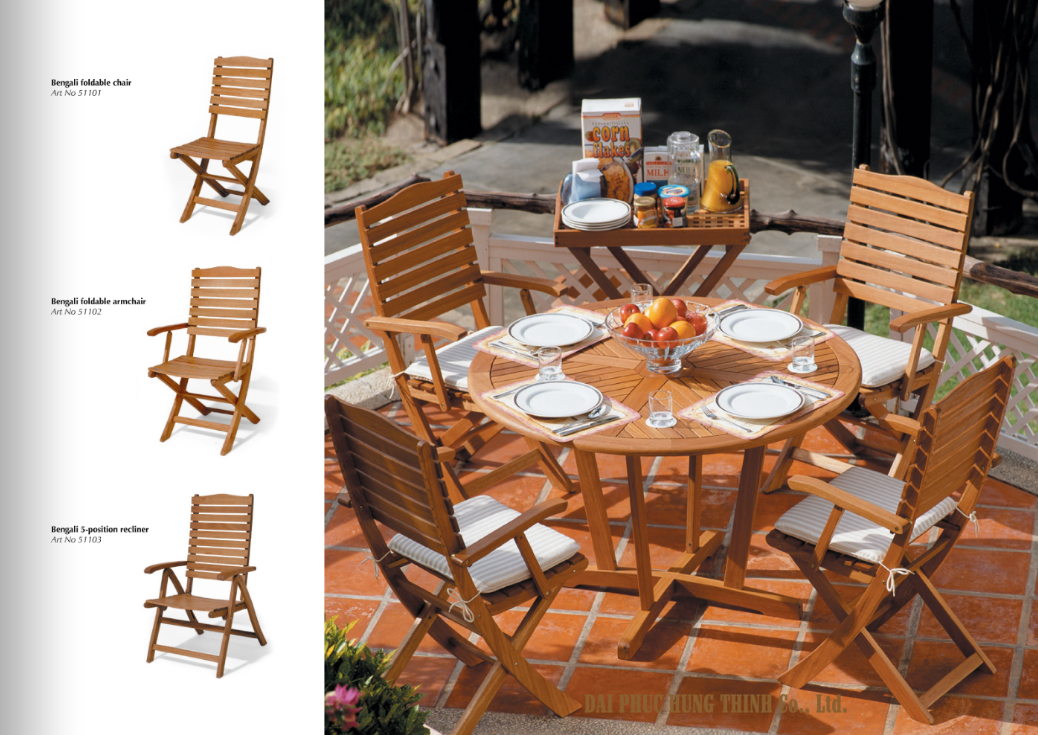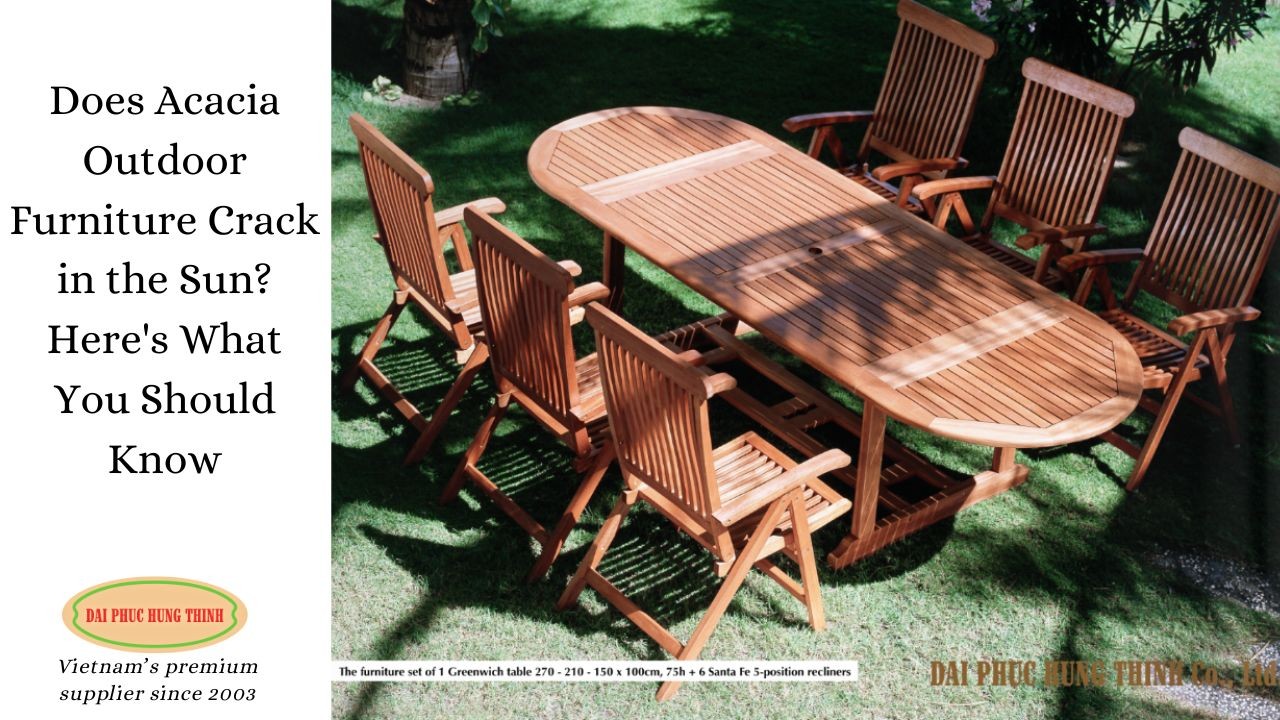Acacia wood is widely recognized for its strength, beauty, and natural durability, making it one of the most popular choices for outdoor wooden furniture. But even premium hardwoods aren’t immune to the elements—especially during the peak summer months, when sun exposure is at its most intense.
If you’ve ever asked, “Will my acacia furniture crack in the sun?”, or “How can I protect my garden table from drying out this summer?”, this article breaks down the science behind sun damage and what you can do to extend the life of your acacia furniture—whether you're a homeowner, a garden center buyer, or a furniture retailer.
Can Acacia Furniture Crack in the Sun?
 Pictured above: Dai Phuc Hung Thinh's Greenwich dining set under the beautiful summer sunlight.
Pictured above: Dai Phuc Hung Thinh's Greenwich dining set under the beautiful summer sunlight.
Yes—but only if left unprotected over time.
Acacia is a dense hardwood with a tight grain structure, making it more resistant to weathering than many softwoods or untreated timbers. However, like all organic materials, it can react to environmental stress, particularly heat and UV radiation—both of which peak in summer.
The Science Behind It:
-
UV rays break down lignin, the natural glue that binds wood fibers. This leads to photodegradation, a process that causes color fading, surface roughness, and weakened structural bonds.
-
In intense sunlight, acacia wood can lose internal moisture, especially from surface layers. This drying causes the wood fibers to contract unevenly, leading to surface checking—a mild form of cracking.
-
Thermal expansion and contraction also play a role. Wood naturally expands in humidity and contracts when dry. Repeated cycles of this, combined with direct sun exposure, can stress joints and fibers, particularly if the furniture is left unoiled.
So while acacia is well-suited for the outdoors, prolonged exposure during summer without care can lead to cracking, especially in hot, dry climates or during heatwaves.
How to Prevent Cracking in Acacia Wood (Especially in Summer)
The good news is that acacia furniture can remain crack-free and beautiful for many years with the right care. Here’s what we recommend:
1. Apply a Protective Oil Finish
Oiling acacia wood creates a hydrophobic barrier, reducing the wood’s rate of water loss and shielding it from UV damage. It doesn’t just preserve the color—it helps maintain the cellular integrity of the wood fibers.
-
Use high-quality teak oil or hardwood oil made for outdoor use.
-
Apply once every 2–3 months during high UV seasons—especially in summer.
-
Always clean the surface before reapplying to avoid sealing in dust or debris.
2. Keep Furniture Out of Direct, Prolonged Sunlight
While acacia can handle outdoor use, placing it in partial shade or under a pergola, umbrella, or canopy will drastically reduce UV stress and slow down moisture loss—especially important during long, hot summer days.
If permanent shade isn't an option, rotate your furniture regularly to minimize uneven exposure, which can lead to patchy drying and localized cracks.
3. Use Breathable, UV-Resistant Covers
Furniture covers aren’t just for winter. In hot summers, breathable covers protect against direct UV radiation while still allowing airflow—preventing trapped humidity or condensation that can damage wood.
Avoid plastic tarps or non-ventilated covers, which can trap heat and cause more harm than good.
4. Avoid Letting Furniture Sit on Hot Surfaces
Patio tiles, concrete, or stone surfaces can reflect additional heat onto the underside of wooden furniture. Using rubber feet or risers can help reduce thermal transfer and allow airflow below the furniture base.
This is particularly helpful during peak summer heat.
5. Clean and Inspect Regularly
Even micro-cracks can be caught early. Regular cleaning (with mild soap and water) and monthly inspection helps spot dryness, raised grain, or early checking before it turns into long-term damage.

Pictured above: Dai Phuc Hung Thinh Furniture's Bengali set.
Bonus Insight: Not All Cracks Are the Same
Surface checking is often superficial and won’t affect structural performance. In fact, many hardwoods develop natural hairline cracks as they age outdoors. What matters is preventing deeper splits or joint failure, which only occur under prolonged neglect or extreme exposure—often in summer when temperatures fluctuate between hot days and cooler nights.
If you do see small cracks forming:
-
Sand lightly with fine-grit sandpaper.
-
Clean and apply oil to rehydrate the surface.
-
Don’t overcorrect with heavy sanding—it can weaken protective layers.
Why Acacia Is Still a Top Outdoor Furniture Choice
With a Janka hardness rating of 1700+, acacia outperforms many popular hardwoods when it comes to outdoor use. It’s dense, sustainably harvested, and naturally rot-resistant. While no wood is invincible, acacia is one of the few materials that balances natural beauty, affordability, and weather performance—as long as it's cared for correctly, especially during the summer months.
Sourcing Acacia Furniture? Work With Trusted Experts
At Dai Phuc Hung Thinh Furniture, we’ve been manufacturing outdoor furniture in Vietnam for over 21 years. We supply leading retailers worldwide (JYSK, Segmuller, among others) with sustainable FSC-certified Acacia and Eucalyptus furniture designed to handle outdoor conditions, including sun, heat, and seasonal exposure.
We apply factory-grade oil finishes to our furniture by default, giving buyers a product that’s ready for use and built for durability. We also provide care guidance and support for all our wholesale clients.
Talk to Us
📩 Want to source high-quality acacia garden furniture?
Contact us at sales@daiphuchungthinh.com.vn for our latest catalog, container options, or to discuss your brand’s specific needs.
🪑 Shopping for your own home? Ask your favorite garden furniture store if they carry Dai Phuc Hung Thinh products— sustainably crafted in Vietnam, built to last generations.


